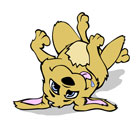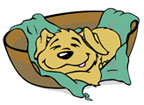Great Dane Dog Breed
Dog Group: Working Group
Class: Working
Description

Dignified, elegant and regal are all words that can be used to describe the appearance of the tall, muscular Great Dane. The Great Dane has a very long, elegant neck and a narrow head.
The coat of this breed is tight-fitting and sleek, with a shiny, glossy appearance. The coat comes in various colors, including: brindle, black, blue, harlequin or fawn.
The Great Dane has a long tail and medium-sized ears. The face has a thoughtful, intelligent expression, adding to its impressive stature.
Temperament
The Great Dane has a very affectionate and sweet disposition. This breed is gentle, patient, calm and loyal, making it an ideal family pet. The Great Dane is excellent with children, and a properly socialized Great Dane will also get along with other pets. However, care must be taken due to its enormous size, as the Great Dane could easily cause accidental injury to a child or other animal. This is a playful and strong-willed breed, and this can often make it difficult to train. However, the Great Dane is patient and eager to please, so your persistence will pay off. These dogs also make very good guard dogs because of their size and loyalty.
Height and Weight
The gentle giant of dogs, the Great Dane can reach around 30-34 inches in height for males, and 28-32 inches for females. A male Great Dane averages around 120-200 pounds in weight, with females reach approximately 100-130 pounds.
Common Health and Behavioral Problems
Like other large breeds, hip dysplasia can result in reduced mobility and swelling in Great Danes. The breed is also prone to stomach bloating and heart disease, so exercise and diet should be carefully monitored.
Ideal Living Conditions
The Great Dane is a large dog, and will do well in an environment with a yard or garden to play in. However, the breed will adapt to apartment life as long as sufficient exercise is provided.
Exercise Requirements
This large dog does need a lot of exercise, and will enjoy a long daily walk. However, be careful not to overdo the exercise due to its susceptibility to heart disease.
Diet and Nutrition
You should not feed the Great Dane any supplements (unless instructed by your vet) as this could result in growth issues. You should also bear in mind that this breed is prone to hear disease, and therefore avoid overfeeding and letting him put on weight. A quality, dry food will help keep him nourished and keep his teeth in good, clean condition. Always provide access to fresh, clean water.
Life Expectancy
The life expectancy of a healthy Great Dane is only around ten years, although some may live to be several years older than this. A healthy lifestyle and diet can help to maximize on lifespan.
Grooming Requirements
The Great Dane has a smooth, glossy coat that required minimal maintenance. A brushing with a firm bristle brush will help to keep the coat in good condition, and you can dry shampoo when required. Bathe if necessary, but bear in mind you will need plenty of room due to the dog’s size! You will need to keep the nails trimmed, or you can take to dog to a groomer to get this done professionally.
Origin
The Great Dane originates from Germany, although it is thought that similar animals were around in Ancient Greece and Rome. The ancestors of this dog, powerful mastiff-type canines, were originally used to hunt boar in the middle ages. However, selective breeding with Irish Greyhounds resulted in a giant, yet sleek and gentle dog that we now know as the Great Dane. The breed was first registered by the American Kennel Club in 1887
 |
 |
Secrets to Dog Training: Consultation
Secrets to Dog Training offers a free consultation with every order! Here is one submitted by Andrea about her Great Dane named Jason...
Andrea's Consultation
Hi my name is Andrea.
We have a 6 month old Great Dane named Jason. We did a lot of reading about the best place to keep Jason during the time we are at work. We understand Great Danes do not like the extremes of our cold Minnesota winters or our hot Minnesota summers. So we built him a 6'x6' kennel in our un-finished basement. What we didn't think about at the time was what to do when we decide to finish out basement. Well, now that time has come and he obviously is still having accidents during the day. Which we can hardly be upset about since he is only 6 months and he is in the kennel most Mondays - Fridays for the full 8 hour work day. Poor little guy, clearly can't hold it for that long yet.
Jason is very much house broke when he's not in the kennel. I know he can hold it for as long as 5-6 hours. I know this because he chooses not to go outside when it rains. Even if someone is standing out there with him-he's such a Scooby Doo! So he holds it until it quits raining. I know that he thinks that is kennel is the only place in the house were he can "go"(with good reason of course.) I know this because I caught him in the act one day when the kennel door was left open. I was shocked and I didn't know what to do. I was torn between scolding him and letting him go. Thinking I would confuse him by scolding him I didn't do anything but stand there in shock. I realize now that I should have scolded him. Since really there isn't much I could do after the fact. Either way, I messed that one up. :(
So my question is how do we start training to get him ready to be left out of the kennel during the work day? Keeping him in the garage is not an option, since the garage is not insulated. Is this something we need to wait for him to grow out of? Any other suggestions?
Second question, Jason doesn't let us know he needs to go outside by barking or standing next to the door or anything simple like that. He lets us know he wants to go outside by following me around or nibbling at my hands. We are working on the "no biting" command and I do use it at that time. Any suggestions on this? I'm open to anything at this point. (I do know how this one started, once again it was my fault, I'm sure you can imagine how he figured out how to get me to let him out side) I just don't know how to fix it now! :(
Third, when he wants to come into the house he jumps and/or scratches on the door. I don't always get to catch him in the act and leaving him outside until he finally barks or whines has proven to take hours upon hours in the past. Anything to help with this would be greatly appreciated.
Sincerely
Andrea & Jason
Secrets to Dog Training Reply:
Hi Andrea,
Thanks for your email regarding your Great Dane pup. Jason sounds gorgeous, however I am sure that the various issues you have mentioned can be quite frustrating for you.
Unfortunately, your Great Dane has learned that going in his kennel is ok. When he was a younger puppy, he was forced to eliminate in his crate because he physically couldn't hold it that long. Now, he never bothers trying to hold it, because he assumes that it is ok to go there - he has never been reprimanded or taught otherwise.
I think you were right, however, not to scold him for eliminating in his kennel while you were home. This would only have confused him.
Where are you planning on having him during the day, now that your basement is being finished? Will he be allowed to roam the house? I would assume that he will understand that he has to hold his bladder while in the house, so you shouldn't have any problem. Please be careful, however, not to leave him alone for too long. If he is forced to relieve himself, it is likely to begin a habit that may be difficult to break. If you cannot make it home in time, I recommend that you get a friend to visit, to let him out.
For the first few days of being allowed out of his kennel during the day, I recommend that you only allow him access to one or two rooms. Take his bed and toys out of the kennel, and put them in his new room. Eventually, once you think he has settled into his new routine, you can start leaving more doors open and allowing him access to more of the house - assuming that was your original intention of course.
Are you planning on using the kennel at all? If so, you will have to clean it thoroughly and use an odor neutralizer to remove the smell of urine and feces. Then, once clean, begin feeding him on the spot he would normally use to relieve himself. This will take advantage of the fact that dogs do not like to eliminate in a feeding spot.
I think that for the nibbling of your hands to go outside, you could try re-training him to use a bell. Attach a bell to your door. Whenever he begins nibbling your hands, lead him over to the door, and encourage him to ring the bell either with his nose, or his paw. Then praise him and quickly take him outside to his bathroom area. Once he has eliminated, make a huge fuss of him so he knows what a good boy he is. Hopefully he will quickly realize that by ringing the bell, you will open the door for him.
As for your door being scratched, are there occasions when he is likely to bark? You could try combining his barking with a command "Speak". Then, once he has learned the command, you could sneak around the side of your house, and as soon as he begins scratching, rush over growling a guttural growl ("AAHH"). Ask him to sit and then speak, and when he does, praise him then let him indoors.
In the meantime, you could get a piece of plexi-glass put on your dog where he normally scratches. Once the behavior has stopped, you could then remove the glass.
Please ensure that your dog gets lots of attention and exercise when you are home. Make sure he is well trained in obedience, and that you are using the Alpha techniques so that he knows that you are in charge, and that he is at the bottom of the pack.
I hope this helps Andrea. Good luck, and please let me know how you progress.
Kind regards,
Margaret Gardner
Secrets to Dog Training Team
http://www.kingdomofpets.com/dogobediencetraining
More Resources
 |
 |
Want to find out about more dog breeds? Search here or go to our Dog Breed index.
Got Dog Obedience Training or Problem Behavior Issues?
Is your dog trying your patience on a daily basis? Are you constantly faced with a dog that displays one of the following issues? To find the solution to your problem click on it.. you'll discover the answers to it and other common dog problems you may be facing.
This is the most comprehensive book on dog training and behavior problems around. Best of all... You can download this book to your computer and be reading and using the professionals training techniques in minutes.
About The Author
Daniel Stevens is the renowned dog trainer and author of Secrets to Dog Training: STOP Dog Behavior Problems!, one of the leading dog training guides on the market today selling over 25,743 copies (and counting). He currently heads the Kingdom of Pets dog training team.

